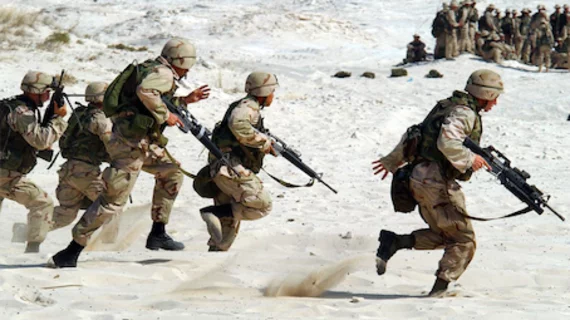War exacerbates CVD risk
A systematic review analyzing the cardiovascular impact of nearly two dozen armed conflicts has identified a link between war and an increased incidence of coronary heart disease, cerebrovascular and endocrine diseases, and other risk factors among civilians.
Heart disease, just like the majority of non-communicable diseases (NCDs), affects a disproportionate number of people in low- to middle-income countries (LMICs), Mohammed Jawad, BSc, MPH, and colleagues wrote in BMJ Heart. That makes it hard to meet the World Health Organization’s goal of cutting premature mortality from NCDs by 25% in the next six years—especially when war is part of the equation.
The Uppsala Conflict Data Program recorded 73 armed conflicts in 2015, most of which took place in LMICs. Jawad and co-authors said the increased military expenditure and political instability associated with war can weaken a country’s infrastructure and stall the progress of healthcare programs, leaving communities in a skewed state of supply and demand.
Jawad et al. looked at 65 studies that analyzed 23 total conflicts, many of which involved the Croatian War of Independence or the Bosnian War. Two-thirds of those studies were considered low-quality, but the authors said that was to be expected.
“Money is tight in conflict-affected countries, so we cannot expect researchers to do high-quality primary research, like cohort studies, to measure the impact of armed conflict,” Jawad, a PhD candidate at Imperial College London, told Cardiovascular Business. “However, we’re in the age of big data. Governments and other organizations are routinely collecting data on the health of their populations over time, and it’s possible to fill in any missing information with sophisticated modelling techniques.”
Considering outcomes including CVDs, diabetes and eight clinical and behavioral factors (blood pressure, blood glucose, lipid levels, tobacco and alcohol intake, BMI, nutrition and physical activity), Jawad and co-authors reported “some evidence” that armed conflict is linked to CV risk factors. The strongest link existed between conflict and coronary heart disease, cerebrovascular and endocrine diseases and increased blood pressure, lipids, alcohol intake and tobacco use.
As for the other outcomes, evidence was either mixed, uncertain or nonexistent. Jawad et al. didn’t find any clear patterning by conflict type, length of follow-up or study quality.
The majority of conflicts the researchers analyzed were based in Balkan countries, which isn’t necessarily applicable to today’s conflicts, many of which center around the Middle East. Still, Jawad said his team’s findings can, in a way, be extrapolated to inform current events.
“On one hand, there’s a lot we can learn from previous wars globally and apply them to the current Middle Eastern context, particularly in the case of protracted wars that generate many refugees,” he said. “On the other hand, it’s important to have Middle Eastern-based research to add context to the current knowledge base around war and health.”
Only one study included in Jawad and colleagues’ analysis looked at refugees, and that study centered around refugee camps in Ethiopia. It found women living in camps just inside the Ethiopian border had worse CV health than those who migrated further into the country, away from conflict-affected countries like Somalia, Sudan and Eritrea. Jawad said the findings are relevant in today’s political climate—there are still numerous Syrian refugee camps in Turkey, for example—but can’t necessarily be extended to the immigration crisis in the U.S.
Jawad and his team are moving forward with research on how armed conflict affects other health conditions, like cancer, but for now he recommends policymakers focus on grounding CVD management and prevention in primary care, where it’s cheaper but just as effective as specialist care.
“It’s also important that any clinics, makeshift or otherwise, that are built by humanitarian agencies are done so in collaboration with local development plans,” he said. “This is so that after the conflict ends, the built infrastructure can meaningfully contribute to the needs of the local population. A bad example is building a primary care clinic in a rural area just to serve the local refugee camp, which then becomes redundant when the conflict ends.”

